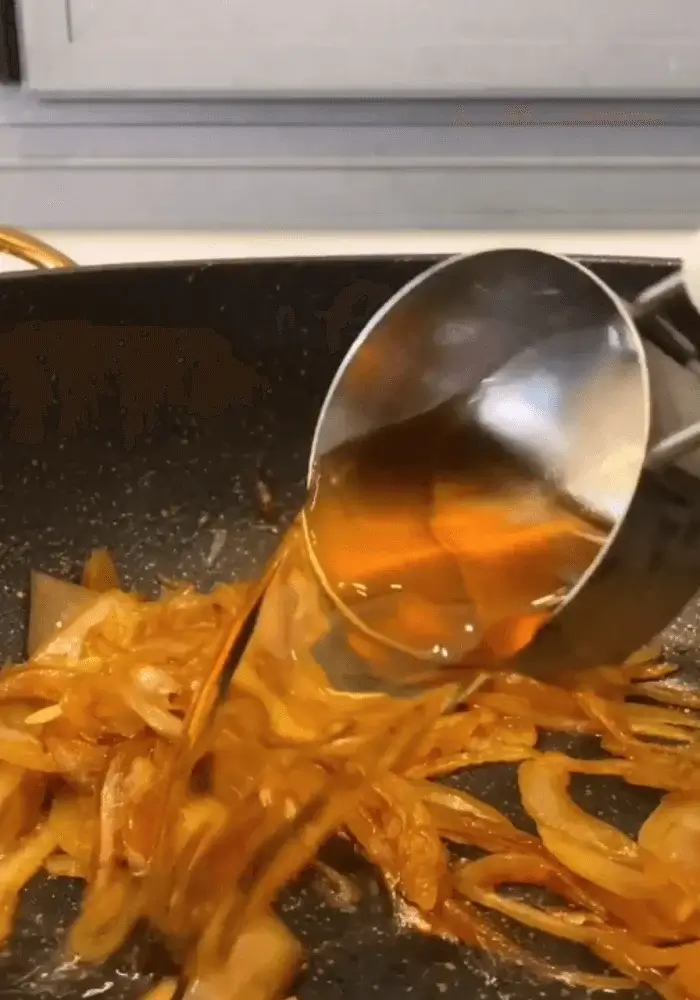Silky Chestnut Soup with Sweet Potatoes
We may earn a commission from recommended products, at no extra cost to you. See Disclosure.
- Pot with a lid
- Blender
INGREDIENTS
- 2 medium onions, finely chopped
- 1 tablespoon olive oil
- ½ cup dry white wine
- 1 tablespoon date syrup
- 3 garlic cloves, minced
- 1 teaspoon brown sugar
- 2 medium sweet potatoes, peeled and diced
- 3.5 ounces/100 grams chestnuts, peeled and roasted
- 1 teaspoon salt, or more to taste
- Water, as needed
INSTRUCTIONS
- Heat the olive oil in a large pot over medium heat. Add the onions and cook, stirring occasionally, until deeply golden and caramelized, about 10 minutes.
- Stir in the date syrup, brown sugar, and garlic. Let it cook for another minute until fragrant. Pour in the white wine and let it simmer until slightly reduced.
- Add the sweet potatoes, chestnuts, and a generous pinch of salt. Pour in enough water to just cover the vegetables. Bring to a boil, then reduce heat and simmer until the sweet potatoes are fork-tender, about 30 minutes.
- Using an immersion blender (or transferring in batches to a countertop blender), purée the soup until smooth and silky. Adjust seasoning as needed.
- Ladle into bowls and garnish with croutons and grated cheese, if desired.
RECIPE NOTES

FAQ
What can I use instead of date syrup in this chestnut soup recipe?
If you don’t have date syrup on hand, you can substitute it with other natural sweeteners. Maple syrup is a great alternative, providing a similar depth of sweetness with subtle caramel notes. Honey also works well, though it’s slightly sweeter and has a distinct floral taste. If you prefer a more neutral option, agave syrup can balance the flavors without overpowering the soup. Molasses is another possibility, though it has a stronger, more robust taste, so use it sparingly. Even a small amount of brown sugar dissolved in a bit of hot water can mimic date syrup’s sweetness. Choose the substitute that best aligns with your taste preferences and the ingredients you have available.

How do I store leftovers of the chestnut soup?
To store leftover chestnut soup, let it cool to room temperature before transferring it to an airtight container. Refrigerate the soup for up to 4 days. When reheating, warm it gently on the stovetop over low to medium heat, stirring occasionally to prevent sticking or burning. If the soup thickens too much in the fridge, add a splash of water or broth while reheating to reach your desired consistency. For longer storage, freeze the soup in freezer-safe containers or heavy-duty freezer bags for up to 3 months. Thaw overnight in the refrigerator before reheating, and blend briefly if the texture separates.

Is it possible to make this soup dairy-free?
Yes, this chestnut soup can easily be made dairy-free without sacrificing flavor or creaminess. The original recipe is already dairy-free, but if you want to add a creamy finish without dairy, use coconut milk, oat cream, or cashew cream. These plant-based options blend smoothly into the soup, adding richness and body. When topping the soup, opt for dairy-free cheese alternatives or skip the cheese altogether and add toasted seeds or nuts for texture. A swirl of extra virgin olive oil or dairy-free yogurt can replace traditional cream, creating a similar effect with entirely plant-based ingredients.
How can I add more protein to this recipe?
To increase the protein content of this chestnut soup, consider adding ingredients that blend well with its flavor. White beans or cannellini beans are a great option, as they have a mild taste and creamy texture. You can add them during cooking and blend them into the soup. Another option is to incorporate cooked lentils, which add protein and fiber. For a non-vegetarian approach, shredded chicken or crispy bacon bits make flavorful additions. You can also top the soup with roasted chickpeas or serve it with a side of whole-grain bread and hummus for a complete, protein-rich meal.

Can I use canned chestnuts instead of roasted ones?
Yes, canned chestnuts work well in this soup and can save you time. Look for unsweetened, unflavored chestnuts packed in water or vacuum-sealed bags. Drain and rinse them if necessary before adding them to the soup. The texture and flavor of canned chestnuts are very close to roasted ones, though roasting enhances their natural sweetness and adds a subtle smokiness. If you want to mimic that depth of flavor, briefly toast the canned chestnuts in a dry skillet or roast them in the oven for 5–10 minutes. This step is optional but can elevate the final taste of your soup.
What herbs pair well with chestnut soup?
Several herbs complement chestnut soup’s earthy, sweet flavors. Thyme is a classic choice, adding subtle woodsy notes that balance the sweetness of the chestnuts and sweet potatoes. Sage brings a warm, savory depth, especially if lightly fried in olive oil and used as a crispy garnish. Rosemary, used sparingly, can add a fragrant, pine-like aroma. For freshness, parsley or chives work well as finishing herbs. If you want a hint of spice, a pinch of nutmeg or ground cinnamon can enhance the soup’s flavor profile. Experiment to find your favorite combination, or mix and match herbs for complexity.

How do I thicken the soup if it’s too thin?
If your chestnut soup turns out thinner than desired, there are several ways to thicken it. The simplest method is to let it simmer uncovered for an additional 10–15 minutes, allowing excess liquid to evaporate. Alternatively, blend in more cooked sweet potatoes or chestnuts to naturally thicken the soup. If you want a quicker fix, stir in a small amount of cornstarch or flour slurry (mix with cold water first) and cook the soup for a few more minutes until it thickens. You can also add a splash of unsweetened plant-based cream or coconut milk for extra body.
Can this recipe be frozen for later use?
Yes, this chestnut soup freezes well, making it a convenient option for meal prep. Allow the soup to cool completely before transferring it to freezer-safe containers or heavy-duty freezer bags. Leave a little space at the top for expansion. The soup can be frozen for up to 3 months. When you’re ready to eat it, thaw the soup overnight in the refrigerator. Reheat it gently on the stovetop over low to medium heat, stirring occasionally. If the soup’s texture separates after freezing, use an immersion blender to restore its smooth consistency. Add a splash of water or broth if needed.

